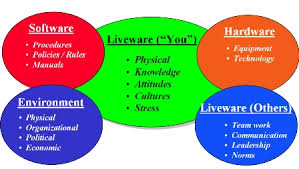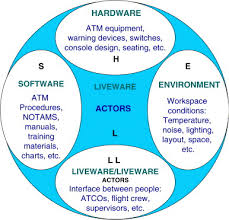SHEL(L) Model
“SHEL” model : The component blocks of the SHEL model : Software, Hardware, Environment, Liveware). The interpretations are: liveware (human), hardware (machine), software (procedures, symbology, etc.) and environment.


Liveware (the human) is at the centre of the model. Human is generally considered the most critical as well as the most flexible component in the system. Yet people are subject to considerable variations in performance and suffer many limitations, most of which are now predictable in general terms. The edges of this block are jagged, and so the other components of the system must be carefully matched with them if stress in the system and eventual breakdown are to be avoided.
Physical size and shape. In the design of workplace and equipment, a vital consideration involves body measurements and movements, which may vary according to factors such as age, ethnicity and gender. Human Factors inputs must be provided at an early stage in the design process, and data for these inputs are available from anthropometry, biomechanics and kinesiology.
Physical needs. People's requirements such as for food, water and oxygen are indicated in human physiology and biology.
Input characteristics. Humans possess various sensory systems for collecting information from the world external as well as internal to them, enabling them to respond to events and to carry out the required task. All senses may, however, be subjected to degradation for one reason or another, and the sources of knowledge include psychology and physiology.
Information processing. human functions have limitations. Poor instrument and alerting system design has frequently resulted from a failure to take into account the capabilities and limitations of human information processing. Factors such as stress, motivation and short- and long-term memory are involved. Psychology and cognitive sciences are the sources of background knowledge here.
Output characteristics. Once information is sensed and processed, decisions are made and/or messages are sent to muscles to initiate the desired response. Responses may involve a physical control movement or the initiation of some form of communication. Acceptable control forces and direction of movement have to be known, and biomechanics, physiology and psychology provide the background knowledge.
Environmental tolerances. Environmental factors such as temperature, vibration, pressure, humidity, noise, time of day, amount of light and G-forces can affect human performance and well-being. Heights, enclosed spaces and a boring or stressful work environment can influence human behaviour and performance. Background information is available from medicine, psychology, physiology and biology.
Liveware is the hub of the SHEL model of Human Factors. The remaining components must be adapted to and matched with this central component.


Liveware-Hardware. This interface is the most commonly considered when speaking of human-machine systems: the design of seats to fit the sitting characteristics of the human body; of displays to match the sensory and information-processing characteristics of the user; of controls with proper movement, coding and location. The user may not be aware of an L-H deficiency, even when it finally leads to disaster, because the great virtue of human adaptability may mask the effects of such a deficiency. However, the deficiency continues to exist and may constitute a potential hazard. Ergonomics deals mostly, although not exclusively, with issues arising from this interface.
Liveware-Software. This encompasses the interface between humans and the non-physical aspects of the system such as procedures, manual and checklist layout, symbology and computer programmes. The problems may be less tangible than those involving the L-H interface and consequently more difficult to detect and resolve (e.g. misinterpretation of checklists or symbology).
Liveware-Environment. The human-environment interface was one of the earliest recognized in aviation. Initially, measures taken were aimed at adapting the human to the environment (e.g. by using helmets, flying suits, oxygen masks and G suits). Later, attempts were made to alter the environment to match human requirements (e.g. by applying pressurization, air-conditioning and soundproofing).
Liveware-Liveware. This is the interface between people. Flight crew training and proficiency testing have traditionally been conducted on an individual basis. If each individual crew member was proficient, then it was assumed that the team comprising those individuals would also be proficient and effective. This is not always the case, however, and for many years attention has been increasingly turned to the breakdown of teamwork. Flight crews function as groups and group interactions play a role in determining behaviour and performance. In this interface, one is concerned with leadership, crew cooperation, teamwork and personality interactions.
Liveware (the human) is at the centre of the model. Human is generally considered the most critical as well as the most flexible component in the system. Yet people are subject to considerable variations in performance and suffer many limitations, most of which are now predictable in general terms. The edges of this block are jagged, and so the other components of the system must be carefully matched with them if stress in the system and eventual breakdown are to be avoided.
Physical size and shape. In the design of workplace and equipment, a vital consideration involves body measurements and movements, which may vary according to factors such as age, ethnicity and gender. Human Factors inputs must be provided at an early stage in the design process, and data for these inputs are available from anthropometry, biomechanics and kinesiology.
Physical needs. People's requirements such as for food, water and oxygen are indicated in human physiology and biology.
Input characteristics. Humans possess various sensory systems for collecting information from the world external as well as internal to them, enabling them to respond to events and to carry out the required task. All senses may, however, be subjected to degradation for one reason or another, and the sources of knowledge include psychology and physiology.
Information processing. human functions have limitations. Poor instrument and alerting system design has frequently resulted from a failure to take into account the capabilities and limitations of human information processing. Factors such as stress, motivation and short- and long-term memory are involved. Psychology and cognitive sciences are the sources of background knowledge here.
Output characteristics. Once information is sensed and processed, decisions are made and/or messages are sent to muscles to initiate the desired response. Responses may involve a physical control movement or the initiation of some form of communication. Acceptable control forces and direction of movement have to be known, and biomechanics, physiology and psychology provide the background knowledge.
Environmental tolerances. Environmental factors such as temperature, vibration, pressure, humidity, noise, time of day, amount of light and G-forces can affect human performance and well-being. Heights, enclosed spaces and a boring or stressful work environment can influence human behaviour and performance. Background information is available from medicine, psychology, physiology and biology.
Liveware is the hub of the SHEL model of Human Factors. The remaining components must be adapted to and matched with this central component.
Liveware-Hardware. This interface is the most commonly considered when speaking of human-machine systems: the design of seats to fit the sitting characteristics of the human body; of displays to match the sensory and information-processing characteristics of the user; of controls with proper movement, coding and location. The user may not be aware of an L-H deficiency, even when it finally leads to disaster, because the great virtue of human adaptability may mask the effects of such a deficiency. However, the deficiency continues to exist and may constitute a potential hazard. Ergonomics deals mostly, although not exclusively, with issues arising from this interface.
Liveware-Software. This encompasses the interface between humans and the non-physical aspects of the system such as procedures, manual and checklist layout, symbology and computer programmes. The problems may be less tangible than those involving the L-H interface and consequently more difficult to detect and resolve (e.g. misinterpretation of checklists or symbology).
Liveware-Environment. The human-environment interface was one of the earliest recognized in aviation. Initially, measures taken were aimed at adapting the human to the environment (e.g. by using helmets, flying suits, oxygen masks and G suits). Later, attempts were made to alter the environment to match human requirements (e.g. by applying pressurization, air-conditioning and soundproofing).
Liveware-Liveware. This is the interface between people. Flight crew training and proficiency testing have traditionally been conducted on an individual basis. If each individual crew member was proficient, then it was assumed that the team comprising those individuals would also be proficient and effective. This is not always the case, however, and for many years attention has been increasingly turned to the breakdown of teamwork. Flight crews function as groups and group interactions play a role in determining behaviour and performance. In this interface, one is concerned with leadership, crew cooperation, teamwork and personality interactions.
A short and good account of the SHELL for users. Good job.
ReplyDelete